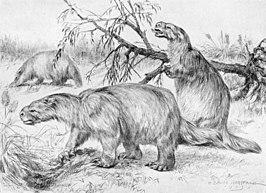Glossotherium
| Glossotherium Status: Uitgestorven Fossiel voorkomen: Plio-Pleistoceen (~ 2,5 - 0,010 Ma) | |||||||||||||
|---|---|---|---|---|---|---|---|---|---|---|---|---|---|

| |||||||||||||
| Skelet van Glossotherium robustus | |||||||||||||
| Taxonomische indeling | |||||||||||||
| |||||||||||||
| Geslacht | |||||||||||||
| Glossotherium Owen, 1840 | |||||||||||||
| Typesoort | |||||||||||||
| Glossotherium robustum (= Mylodon robustus Owen, 1840) | |||||||||||||

| |||||||||||||
| Afbeeldingen op | |||||||||||||
| |||||||||||||
Glossotherium[1][2][3][4] is een geslacht van grondluiaards, een groep van uitgestorven zoogdieren. Er zijn ten minste vier soorten in het geslacht benoemd.
Beschrijving
[bewerken | brontekst bewerken]Soorten uit het geslacht Glossotherium hadden een lengte tot vier meter en een gewicht tot 1,5 ton. Deze grondluiaards hadden een grote kop en een zware staart. De goed ontwikkelde neusbotten wijzen op een goede reukzin. De soorten waren bewoners van open gebieden, en voedden zich met gras en twijgen.
Fossiel verspreidingsgebied
[bewerken | brontekst bewerken]Glossotherium leefde vanaf het Laat-Plioceen tot Pleistoceen en had een verspreidingsgebied dat liep van de Verenigde Staten tot in Zuid-Amerika.
Bronnen, noten en/of referenties
Literatuur
- Bergqvist, L. P., M. Gomide, C. Cartelle and R. Capilla. 1997. Faunas-locais de mamiferos Pleistocenicos de Itapipoca/Ceara, Taperoa/Paraiba e Campina grande-Paraiba; estudo comparativo, bioestratinomico e paleoambiental. Revista Universidade Guarulhos Geociencias, 2(6): 23-32.
- Vialou, A. V., . Aubry, M. Benabdelhadi, C. Cartelle, L. Figuti, M. Fontugne, M. E. Solari and D. Vialou. 1995. Decouverte de Mylodontinae dans un habitat prehistorique date du Mato Grosso (Bresil); l'abri rupestre de Santa Elina. Comptes Rendus de l'Academie des Sciences, Serie II. Sciences de la Terre et des Planetes, 320(7): 655-661.
- Alberto Boscaini; Dawid A. Iurino; Raffaele Sardella; German Tirao; Timothy J. Gaudin; François Pujos (2019). "Digital cranial endocasts of the extinct sloth Glossotherium robustum (Xenarthra, Mylodontidae) from the late Pleistocene of Argentina: description and comparison with the extant sloths". Journal of Mammalian Evolution. in press. doi:10.1007/s10914-018-9441-1
- Cástor Cartelle; Gerardo De Iuliis; Alberto Boscaini; François Pujos (2019). "Anatomy, possible sexual dimorphism, and phylogenetic affinities of a new mylodontine sloth from the late Pleistocene of intertropical Brazil". Journal of Systematic Palaeontology. Online edition. doi:10.1080/14772019.2019.1574406.
Noten
- ↑ Glossotherium (white background). prehistoric-fauna.com. Gearchiveerd op 16 mei 2023. Geraadpleegd op 16-05-2023.
- ↑ Glossotherium robustum. prehistoric-fauna.com. Gearchiveerd op 16 mei 2023. Geraadpleegd op 16-05-2023.
- ↑ Glossotherium. www.prehistoric-wildlife.com. Gearchiveerd op 16 mei 2023. Geraadpleegd op 16-05-2023.
- ↑ Fossilworks: Glossotherium. www.fossilworks.org. Gearchiveerd op 13-12-2021. Geraadpleegd op 16-05-2023.
- Glossotherium in de Paleobiology Database